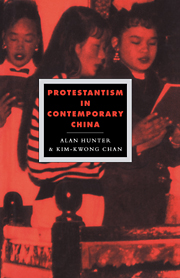Book contents
- Frontmatter
- Contents
- List of figure and tables
- General editors's preface
- Acknowledgements and notes on the text
- List of abbreviations
- Map
- Introduction
- 1 The social and political context
- 2 A survey of the Protestant community
- 3 The historical legacy
- 4 Protestantism and Chinese religious culture
- 5 Varieties of Christian life
- 6 Buddhism and Catholicism
- 7 Into the 1990s
- Bibliography
- Index
4 - Protestantism and Chinese religious culture
Published online by Cambridge University Press: 04 May 2010
- Frontmatter
- Contents
- List of figure and tables
- General editors's preface
- Acknowledgements and notes on the text
- List of abbreviations
- Map
- Introduction
- 1 The social and political context
- 2 A survey of the Protestant community
- 3 The historical legacy
- 4 Protestantism and Chinese religious culture
- 5 Varieties of Christian life
- 6 Buddhism and Catholicism
- 7 Into the 1990s
- Bibliography
- Index
Summary
PRAYER AND THE INDIGENOUS TRADITION
The Chinese people approached by the missionaries had already created a culture with richly varied religious traditions, some aspects of which were surprisingly similar to those of Protestantism itself. Christianity, as it began to spread, encountered an environment imbued with religious beliefs, practices, traditions and organizations, many of which still show signs of great vitality today. Interaction with the indigenous traditions is arguably the most important single formative factor of Chinese Christianity, but to date it has attracted little scholarly attention; the present chapter is, therefore, necessarily tentative and exploratory. In the first five sections we focus on key areas that call for further comparative study.
Human beings have long believed in the possibility of communication with divine or spiritual entities. This activity, ‘prayer’, is an essential feature of religion in every culture. A commonly found form is the recitation of a sacred text, corporately, individually or by a religious specialist. Often such a text is not comprehensible to the participants, since it may be in an archaic language, formulaic or an incantation. In this case the prayer is a kind of meta-language with ritualistic functions that may be extremely effective in creating mood, evoking a spiritual atmosphere and an emotional response. Alternatively, prayer may be free, spontaneous, in colloquial speech and immediately comprehensible. The intention of praying, or the nature of the communication, may also contain disparate elements even within the same tradition: some common uses of prayer are as petition, invocation, adoration, confession and intercession.
- Type
- Chapter
- Information
- Protestantism in Contemporary China , pp. 141 - 175Publisher: Cambridge University PressPrint publication year: 1993



